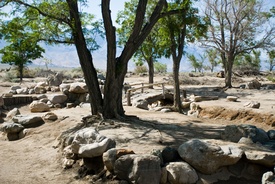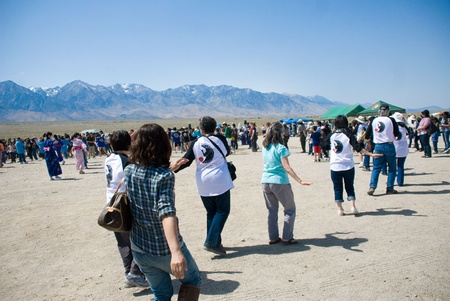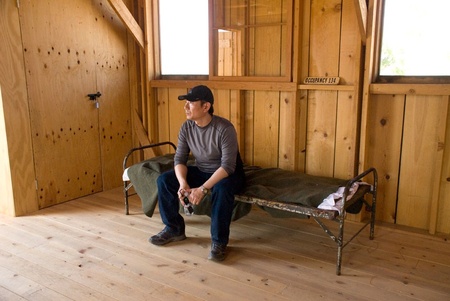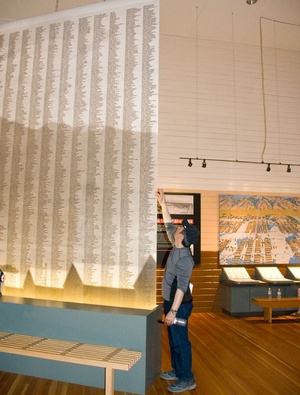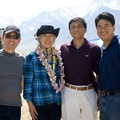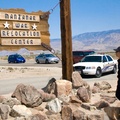Read Part 2 >>
Breathless and exhausted from the hot desert sun, jet lag and bus ride, I now believe that I was running only on fumes. At the ceremonies end, Pilgrims of all faiths gathered around the large white memorial stone obelisk. Quiet and somber, priests and pastors take their turns giving service, and then my memory is rocked by the unmistakable sound of a Buddhist Priest chanting and the scent of burning incense. I am thrown back into my childhood hearing the haunting drone from the priests. In my mind’s eye, I can see my mom, Buddhist beads wrapped around her hands, praying at my Bachan’s funeral when I was little. At that age, I used to listen to them talk about “camp.” Was it like my Cub Scout camp?
“Swallow what we give you. Sleep here where we say.
You don’t need your privacy in this desert hideaway.
You still have your freedom. Just stay behind that wire.
If you get unreasonable, then Ready. Aim and Fire!”*
As the chanting ends, a huge circle of people forms organically. Pouring out from the speakers comes that crazy, tinny o-bon music from somewhere deep in my childhood. My heart wells up when I see the uniformed park rangers joining the joyful, wacky dance! Pilgrims were offered an optional walking tour and of course, I wanted to feel the earth. Our tour guides, Patricia Biggs and Marie Masumoto walked us through the vast property. Although the camp was razed when evacuated, there are key and very telling remnants of the structures. Most remarkable were the ponds and beautification areas. Here was a massive collective of unwilling prisoners, and yet these spat-upon souls take the time to re-route water sources, design and execute the most serene ponds and fountains. Marie is part of a team that voluntarily excavates and restores these areas. Unfunded, they were digging out years of dirt by hand until recently. One of these ponds featured a turtle-shaped rock fountain and a handmade wooden bridge. Incredible was the spirit of these people. I promise myself to try and not monku (bitch) so much about the petty stuff that bothers me in this life.
I’ve been obsessed with seeing the barracks for years. I still have my mother’s scratchy wool army blanket that she brought back from Manzanar. I enter the second barrack. Raw wood. Black paper walls. Tiny metal cots. I know I’m not supposed to, but I need to sit down on one. As a father and a man, I try and imagine that I must bring my wife and daughters here, knowing I cannot leave for the foreseeable future.
Complicated thoughts race back and forth and I want to linger, but alas, time is short and my bus will be leaving soon. It occurs to me that Mom had little hope for a bus out of this God forsaken box. As I walk towards the museum, I see a group of 30 Islamic students have laid out their carpets and kneel for sundown prayer.
The old wives-tale about finally facing up to something that you’ve feared/avoided/imagined for a long time says that you surely will be let down. Definitely not true. I am now on some kind of exhausted, adrenaline rush as I speed though the museum’s exhibits. I try and absorb it all, but four hours in the desert sun and emotional overload has turned my synapses into “mochi.” As if on cue, I come across a gigantic fabric wall. Names. Maybe 11,000 names on it. Tired and frustrated with the bus waiting, I can’t find my mom’s name. I’m starting to lose it. My hallucinogenic sunburned and dehydrated mind is thinking that if I don’t see her name, the entire journey would be a failure. Thank God/Buddha Walter has a zoom lens! He locates it about ten feet up and I spot it. Sorry, no words to describe that moment.
Spent, we straggle back to the bus. Those friendly retired schoolteachers look so fresh, and I’m so wilted. They must be experienced soul searchers! During the quiet hazy bus ride home, the mind replays, digests and heals. As we pull up at St. Frances Xavier, Martha asks me to lead the bus in singing “This Land is Your Land.” Our collective voices are wonderfully tired, scratchy and unified.
Webster’s Dictionary defines “chaser” as “a mild drink taken after hard liquor.” The next day I followed up at the Japanese American National Museum. If walking Manzanar was the hard stuff, the J.A.N.M. was the perfect “chaser.” Everything made sense there. It is a must see, either before or after. By the way, I’m a pathetic drinker. I have the “turn red” gene.
Strange about this type of journey. I’ve often thought about places to go on my “bucket list.” Of course I still hope to see DaVinci’s works at the Louvre, but I now realize that when it’s time to kick the proverbial “bucket,” Manzanar was the only one that I NEEDED to see. If you are a thinking American, you may not want to see concentration camps on U.S. soil, but you NEED to see them.
I could never truly know what a 14 year old girl named Ruthie went through in the first hours of incarceration, but by shadowing her movements and gathering, listening and sharing with others who are cut from the same cloth, I find solace.
This internal map of my Pilgrimage is dedicated to my mom, my family, The CJAHS and my newfound family that is the Manzanar Committee.
In ’45 they freed us. Everything was icy yet.
They said “here’s a little money, sonny…
Let’s forgive and just forget”
But it ain’t really over now.
Look around and you’ll see the signs.
Watch the ones that run the show…
Simple deeds from the narrow minds.
Liar. We the people—can you tell us the truth?
Liar. See me now—can you give me back my youth?*
*Excerpt from LIAR ©2001 Keith Uchima, Delectable Music (available on iTunes)
*This article was originally published on the Chicago Japanese American Historical Society on May 27, 2012.
©2012 Keith Uchima


